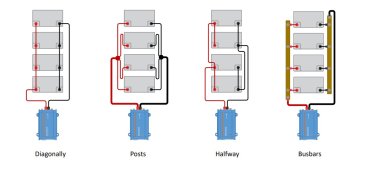I'm considering getting about 300AH of 12v battery(ies) for my RV. Currently I have 1x100AH Ampiere Time 12v, a Victron 12/3000 inverter, and 4/0 wiring where it makes sense.
The BMS on the battery maxes out at 100A continuous (rated), so I figured I'd run a max test with the A/C turned on. I had it run for about 15 min, drawing anywhere from 100-130A according to my smart shunt. I noticed the positive terminal on the battery got quite hot to the touch, but the rest of the battery felt cool.
Now, running the A/C on a 100AH battery with a 100A BMS is not a good idea, I know, so I'd like to either get a total of 3x100AH batteries OR 1x300AH battery (with a 200AH BMS).
My question is, if I do 3x100AH and wiring them in a diagonal config (see picture from Victron guide), will I still have the same heat problem on the positive terminal that feeds the rest of the system, even though I could theoretically use 300A of continuous current with that configuration? It seems to me the heat problem on that terminal might even be worse, since 300A of current might flow through the internal battery wires (6AWG?) and the terminal.
Without seeing a teardown of the 300AH Ampiere Time battery, I'd think that the internal wiring would be beefier if it has a 200A BMS, so heat wouldn't be as much of a problem.
Next question: If my above concern is valid - heat buildup in diagonal config - should I just use the "Posts" or "Busbars" configuration to mitigate that?

The BMS on the battery maxes out at 100A continuous (rated), so I figured I'd run a max test with the A/C turned on. I had it run for about 15 min, drawing anywhere from 100-130A according to my smart shunt. I noticed the positive terminal on the battery got quite hot to the touch, but the rest of the battery felt cool.
Now, running the A/C on a 100AH battery with a 100A BMS is not a good idea, I know, so I'd like to either get a total of 3x100AH batteries OR 1x300AH battery (with a 200AH BMS).
My question is, if I do 3x100AH and wiring them in a diagonal config (see picture from Victron guide), will I still have the same heat problem on the positive terminal that feeds the rest of the system, even though I could theoretically use 300A of continuous current with that configuration? It seems to me the heat problem on that terminal might even be worse, since 300A of current might flow through the internal battery wires (6AWG?) and the terminal.
Without seeing a teardown of the 300AH Ampiere Time battery, I'd think that the internal wiring would be beefier if it has a 200A BMS, so heat wouldn't be as much of a problem.
Next question: If my above concern is valid - heat buildup in diagonal config - should I just use the "Posts" or "Busbars" configuration to mitigate that?



